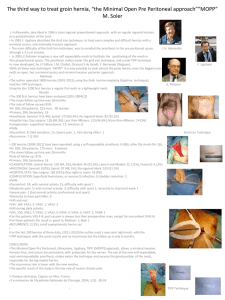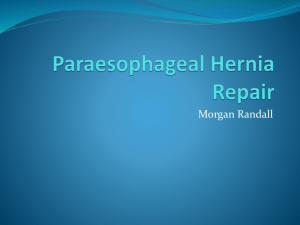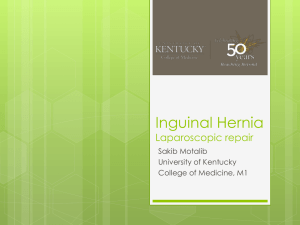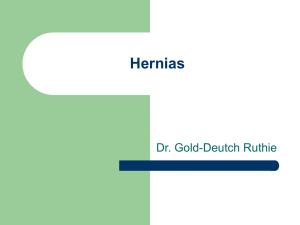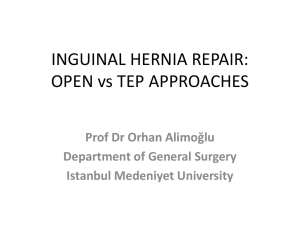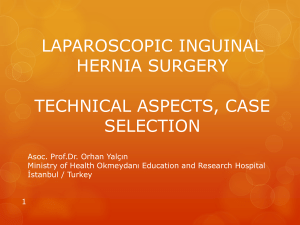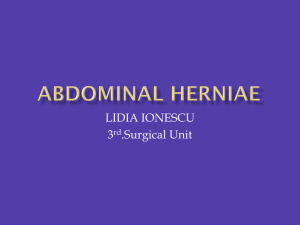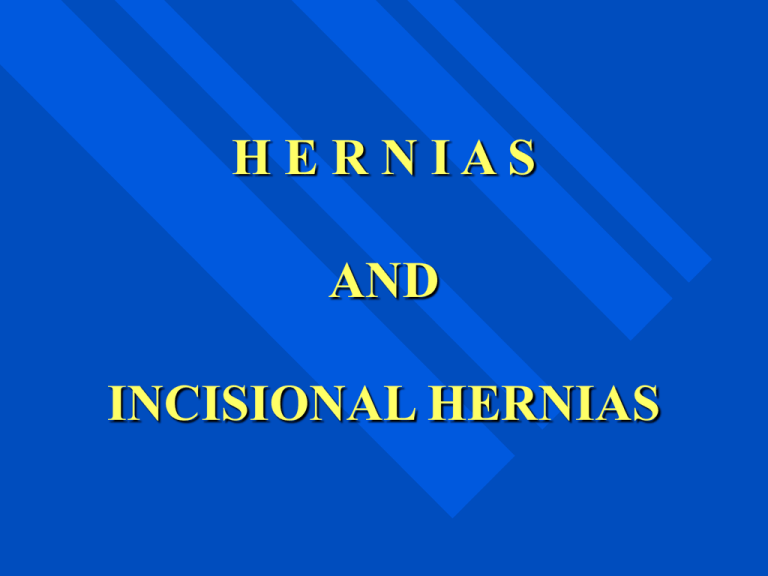
HERNIAS
AND
INCISIONAL HERNIAS
Definition:
Hernia develops whenever the lining or
contents of one finite anatomic space
protrudes abnormally either into a
surrounding tissue plane or into some
adjacent body cavity
The defective hiatus in supporting
structures is generally referred to as a
ring or neck, while an outpocketing from
the parent cavity is called the sac
Allthough a sac need not be present, all
hernias by definition are associated with
a weekness, defect, or dilated hiatus in the
confining wall of a primary compartment
Classification
1.
Anatomical
–
–
–
–
Inguinal hernia (75% of hernias)
Femoral hernia (6%)
Epigastric and ombilical hernia (5%)
Rarer abdominal wall hernias
( obturator, spigelian, lombar, sciatic, perineal)
2.
Clinical
–
–
Reduicible - coercible
- uncoercible
Irreduicible – incarcerated (no vasculary injury)
- strangulated (with vasculary injury)
Anatomy of the inguinal region
Some definitions regarding hernia contents
Reducible – the contents can return to the abdominal
cavity
Ireducible – incarcerated (viable contents)
- strangulated (ischemic or necrotic
contents)
Sliding – part of the wall of the sac may be colon on
the left, caecum on the right, or bladder on
either side
Richter’s hernia – a hernia that has strangulated a
part of the intestinal wall, without compromising
the lumen (stangulation not excluded)
Maydl’s hernia – hernia containing two adjacent
loops of small intestin, with strangulation
of the segment between the loops
Littre’s hernia – a hernia containing a Meckel
diverticulum
Inguinal hernia
Definition:
a protrusion of part of the contents of
the abdomen through the inguinal region
of the abdominal wall
75 % of all hernias
More common in male than in female
Anatomy of the inguinal canal
This canal has the following boundaries
1. Anterior – aponeurosis of the external oblique
2. Posterior – conjoint tendon combined tendon of
internal oblique and transversus abdominis.
3. Roof - arching fibres of internal oblique and
transversus abdominis
4. Floor – inguinal ligament
5. Medially is the pubic symphysis.
6. Laterally is the anterior superior iliac spine.
Contens of the inguinal canal
- spermatic cord in men
- round ligament in women
The inguinal region (posterior view)
Anatomical classification of inguinal hernia
A. Indirect hernia – passes through the intern ring
Direct hernia – passes through the Hasselbach
triangle, a weak point of the posterior wall
of the inguinal canal
- little significance for treatment
B. Inguinal hernia
Inguino-scrotal hernia
Types of inguinal hernia
Precipitating factors
Increased intraabdominal pressure:
- physical activity (ocupational history)
- straining defecation or urination ( rectal or
colon cancer, prostatic enlargement,
constipation)
- obesity
- pregnancy
- ascites
- valsavagenic (coughing)
Presence of an abnormal congenital anatomic
route (patent processus vaginalis)
Clinical features - symptomes
Local symptoms
- Pain or discomfort (there are painless
hernias too)
- A lump in the inguinal region.
! Pain + irreducibility of a previously
reducible hernia = strangulation
=> emergency operation is indicated.
Clinical features - symptomes
Systemic symptoms – are signs of complicated
hernias
- Colicky abdominal pain
- vomiting
- abdominal distension
- absolute constipation
A small defect is more dangerous because a tight
defect is more likely to strangulate
Clinical features - signs
Inspection
- a lump in the inguinal region having expansile
cough impulse
Palpation
- examination of the patient in standing and
lying
- palpation of the inguinal supperficial ring
through the scrotum
- reducible / unreducible
- direct / indirect hernia
Percussion and auscultation
- a hernia that contains gut may be resonant,
and bowel sounds may be audible over it
Differential diagnosis
1. Femoral hernia - below and lateral to pubic tubercle
2. Lymph node - no cough impulsion
- usually below inguinal ligament
3. Varicocele – dilated veins in spermatic cord visible
with patient standing
4. Cyst of canal Nuck – able to get above lump
(females only)
5. Hydrocele – not reducible (males only)
6. Undescebded testis- absence of the testis in scrotum
- may be associated with patent
processus vaginalis
Evolutive complications
Incarceration
Strangulation => infarction and necrosis of
the contents => perforation of the bowel
Rare complications
- local pressure effects on structures in
proximity of the sac
- rupture of the hernia
Treatmet of inguinal hernia
Hernia reduction (taxis)
- should be tried in acute incarcerated hernia
- should be done with gentle efforts
- may need analgesia and sedation
- if unsuccesfully after a few minutes of continous
pressure => emmergency operation (otherwise risk
of injury of the sac contents)
Using of a truss – if surgery is considered
inappropriate
Hernia repair
Basic principles
1. Eliminate or control factors that have favored
the evolution of the hernia
2. Totally remove the sac or at least interrupt the
communication between abdomen and hernia
pouch
3. Correct any associated fascial defect by
- narrowing a normally situated hiatus
- transferring supporting structures to
overcome any fascial weakness
- implanting autogenous fascia or synthetic
substitute
Hernia repair technique
There have been described several techniques
Most used: Halsted, Bassini, Shouldice, McVay,
Ferguson
Approach – transperitoneal (seldom used)
- inguinal
Classification of techniques:
- anatomical
Repair of the abdominal
- prefunicular
wall
- retrofunicular
Steps of the repair of the inguinal hernia
1.
2.
3.
4.
5.
6.
Inguinal incision
Incision of the aponeurosis of the externus
muscle => open the inguinal canal
Dissection of the spermatic cord and isolation of
the hernia sac
Opening the sac, verifying and repositioning its
contents
Ligation and excision of the sac
Reconstruction of the abdominal wall
McVay procedure (retrofunicular)
Shouldice procedure (anatomical)
Laparoscopic repair of inguinal hernia
Is considered appropriate only in indirect hernias
with no muscular defect in the abdominal wall
Laparoscopic herniorrhaphy by insertion of
synthetic mesh to eliminate the muscular defect
associated with an inguinal hernia is now the
procedure most widely used
Femoral hernia
Definition: a protrusion of peritoneum through
the femoral canal
It may contain - abdominal contents
- extraperitoneal fat
Are twice as common on the right side as on the left
Are four times more common in women than in men
Incidence increases with advancing age
Anatomy of the femoral canal
Borders:
- anteriorly - the inguinal ligament
- posteriorly - the pectineal (Cooper's) ligament
medially - the unyielding lacunar ligament, and - laterally
by the iliopsoas muscle
Contents (from lateral to medial):
- the femoral and the genitofemoral nerve
- the femoral artery
- the femoral vein
The sac progresses usually towards the foramen ovale
Anatomy of the femoral canal
Development of femoral hernia
Clinical features
If reducible it may present as an asymptomatic lump
or as localized intermittent discomfort
If it becomes irreducible, the lump and localized
discomfort become constant features
Mild pyrexia + localized discomfort => strangulated
omentum within the hernial sac
Obstruction => strangulated small bowel is likely
Richter's hernias are common in femoral hernias
=> strangulation of the antemesenteric intestinal
wall without obstruction
Occasionally present with visible distension of
the long saphenous vein => the hernia has
extended through the fossa ovalis and is
compressing the sapheno-femoral junction
Because of the tight femoral ring strangulation is
more frequent than in inguinal hernias
Femoral hernias - treatment
Femoral hernias should not be treated conservatively
(impossible to control the hernial neck with a truss
and the incidence of strangulation is high)
Principles of femoral hernia repair:
- excision or reduction of the hernial sac
- and narrowing of the stretched femoral opening
Approaches to femoral hernia repair
The low approach
- is suitable only for the uncomplicated small
elective hernia in a thin patient
- the incision is placed directly over the hernia,
parallel to the inguinal ligament
- the stretched femoral opening is narrowed by
placing one or two non-absorbable sutures
medial to the femoral ring, apposing the
inguinal and pectineal ligaments
Low approach – sac dissection
Low approach – apposition of the
inguinal and pectineal ligament
Approaches to femoral hernia repair
The inguinal approach
- is useful when a concomitant inguinal hernia
needs to be repaired and obligatory when a
femoral hernia is misdiagnosed as an inguinal
hernia
- The same incision as for an inguinal hernia
- The femoral canal is approached through
transversalis fascia on the back wall of the
inguinal canal
- Closure of the tissue layers is then completed
as for an inguinal hernia.
Inguinal approach
Inguinal approach
EPIGASTRIC HERNIA
Is a protrusion of preperitoneal fat through a gap in
the decussating fibres of the supraumbilical portion
of the linea alba. The defect usually occurs where
the linea alba is pierced by a blood vessel
A peritoneal sac may accompany fat through the
defect and may contain omentum but only rarely
bowel
The majority – asymptomatic
Rarely - Vague upper abdominal pain and nausea
associated with epigastric tenderness (more
severe when the patient is lying)
Umbilical hernia
Classification:
1. Congenital (omphalocel, exomphalos)
- At birth the umbilicus is absent and a broad
defect in the abdominal wall is present
through which viscera protrude into the
umbilical cord. Peritoneum, but not skin,
covers the protruding viscera
2. Infantile
-after birth because of the failure of fusion of
the ombilical cord stump to the umbilical ring
- always covered by skin
3. Adult paraumbilical hernia
- is an acquired hernia which occurs following
disruption of the linea alba above, or much less
commonly below, the umbilical cicatrix
- Precipitating factors: obesity
multiple pregnancy
ascites
- Gastrointestinal symptoms due to traction between
the hernial contents and the stomach and colon
- Has a small neck
=> Incarceration and strangulation are common
=> Early operation is advisable
Massive paraumbilical hernia
Umbilical hernia – steps of the repair
Incision
Dissection of the sack
Opening of the sac and contents reduction
Ligation and resection of the sac
Closure of the defect in one or two layers
(Mayo procedure)
- in case of massive defect synthetic mesh
can be used
Incisional hernia
Wounds may fail in one of two ways:
1. Wound dehiscence = partial or complete
disruption of an abdominal wound closure
with protrusion or evisceration of the
abdominal contents
- occurs prior to cutaneous healing
2.Incisional hernia = abnormal protrusion of a
viscus through the musculoaponeurotic layers
of a surgical scar
- lie under a well healed skin incision
Incisional hernia - Ethiology
Preoperative factors:
- obesity
- uraemia
- anaemia
- diabetes
- malnutrition
- malignant disease
- vitamin C depletion
- administration of steroids
or cytotoxic drugs.
- age
- male sex
- previous
irradiation
Incisional hernia - Ethiology
Operative factors
- the type of incision (medial, pararectal, Kocher)
- the choice of suture material
- the method of wound closure
Are less important in the development of incisional
hernia
Incisional hernia - Ethiology
Postoperative factors
- wound sepsis
- increased intra-abdominal pressure due to:
- inadequate postoperative analgesia
- vomiting
- development of a postoperative chest
infection resulting in coughing
- gross distension from paralytic ileus
Incisional hernia – Clinical features
The majority are asymptomatic
Small defects in the scar may result in large hernias
=> incarceration and strangulation
Large hernias are unsightly and may give rise to
abdominal discomfort
Pressure necrosis and ulceration may occur in the
skin overlying a large hernia.
Incisional hernia following laparatomy
for peritonitis
Management of incisional hernia
Conservative - weight loss, elastic corset
Surgical repair – types:
1.In the same way as a laparotomy wound is repaired, with a
mass closure of No. 1 nylon.
2.The rectus sheath may be overlapped as in the ‘Mayo’
double-breasted ‘vest over pants’ repair
3.The defect may be repaired by the use of a darn of nylon
or fascia lata.
4.Lower midline incisions may be amenable to closure by
swinging muscle over to close the defect.
5.Large defects may be repaired by implanting a nonabsorbable mesh of tantalum, Marlex, Mersilene, or
polytetrafluoroethylene (PTFE)
Direct closure with relaxing
aponeurotic incision
The Mayo ‘double breasted’ repair
Repair using a synthetic mesh

